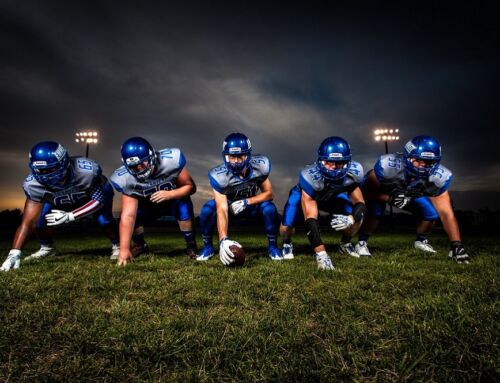America is a divided nation—surely one need only look as far as the comments section on any news article mentioning the words “Trump,” “Clinton,” “taxes,” “healthcare,” “Democrats,” or “Republicans.” In an era of deep social division, there are few things that unify. There is perhaps no greater unifier than our love of football. Although the NFL has recently become embroiled in the culture wars, the sport itself continues to hold a special place in the American heart. Thanksgiving isn’t complete until we all huddle around the television to watch the Lions lose . . . again. It isn’t quite time to belt out Auld Lang Syne until the Big 10 and Pac 12 descend upon the Rose Bowl. February isn’t February until the NFC champion takes the field against the Patriots in the Super Bowl. You get the picture, football is a big deal in America.
Football, however, is under fire. Or, rather, football players are under fire—from themselves. Over the past several years, there has been a national awakening to the threat posed to football players in the form of head injuries. These modern-day gladiators surely take the field knowing they could suffer a life-altering injury to bone and limb, but only recently have we learned they also risk their brains. The problem, of course, is that the players themselves are learning of it just like we are: with report after report of former football greats being reduced to shells of their former selves, beaten down by brain injury. The term du jour is chronic traumatic encephalopathy, or, simply, CTE. Let’s examine what CTE is, what causes it, why it’s so prevalent in football, and what football is doing about it.
According to the Concussion Legacy Foundation, CTE is a degenerative brain disease found in athletes, military veterans, and others with a history of repetitive brain trauma. It has four stages: I through IV. It can cause a range of symptoms, from as minor as memory loss and confusion to dementia and suicide. Regardless of how it starts, what we know for sure is that it will get progressively worse. One of the major problems with CTE is that it can only be diagnosed after death.
It was first observed as early as the 1920s and was originally seen in boxers. It wasn’t until the mid-2000s that it was seen in football players, and when it was, awareness of the disease exploded. It was first identified by a medical examiner named Bennet Omalu during his autopsy of former football player Mike Webster. What followed was an age of discovery for CTE—the Concussion Legacy Foundation, Veteran’s Administration, and Boston University all partnered to create a CTE brain bank. Athletes and others who suspected they may have CTE were able to donate their brains to the brain bank after their death, and there Boston University researchers could learn more about the disease.
The common perception is that CTE is the result of concussions—even the 2015 Will Smith film about Dr. Omalu’s work was called “Concussion.” The reality, however, is that a concussion—in a vacuum—has never been shown to increase the likelihood of developing CTE. Rather, CTE is the result of repeated head trauma, even trauma that does not result in a concussion. More than even multiple concussions, a primary predictor of CTE is the length of time over which an individual experienced repeated head trauma: professional football players are more likely to develop it than college football players, who in turn are more likely to develop it than high school football players.
Professional football players definitely develop CTE. A 2017 study in the Journal of the American Medical Association found that 110 of 111 brains of former NFL players that were included in the study had signs of CTE. More alarming, 90% of the brains of former college players studied exhibited signs of CTE, and more than 20% of the brains of former high school players had the disease. With something as explosive as Dr. Omalu’s finding and subsequent crusade in the mid-2000s, it’s easy to assume that the NFL, as football’s preeminent ambassador to the American public, would have taken steps to immediately inform and protect its players. The opposite occurred. The NFL engaged in a years-long campaign of disinformation, including telling players outright that concussions and other head trauma does not pose a risk to long-term health. For a compelling overview, see PBS’s documentary “League of Denial.” Although the league has taken steps in recent years to protect players—including instituting a “concussion protocol” designed to ensure concussed players do not reenter play—the fact remains that a high number of former players suffer—and will suffer—from the disease.
Players are now trying to fight back. In 2013, a number of players filed a high-profile class-action suit against the NFL, alleging that the league was negligent in informing them of the dangers of the game and protecting them from brain disease. That suit settled this year for more than one billion dollars. Their fight has open the floodgates of litigation. Players from the college have filed suit against the NCAA, parents of players from high school and even Pop Warner have filed suits against those schools and leagues, and some players have even filed suit against helmet makers East-Bell, Inc. and Riddell Sports Group, Inc. for false advertising.
Whether football can ever be made truly safe is uncertain. A new debate has started in our national discourse about how young is too young to play football. Evidence suggests the answer to that question is “no younger than 12.”
Even waiting until High School can open children to the risk of future brain problems. Unfortunately, there is no clear answer. Football provides many benefits to a young adult, and can provide serious financial benefits to a college, semi-professional, or professional player, but ultimately it is up to the parents and their children to make the decision of whether playing football is worth the risk.
If you would like more information on the current CTE lawsuits, the effects of CTE, or how you might pursue a case for damages caused by playing football feel free to contact our experienced brain injury attorneys at the Hurst Limontes LLC by visiting our website or calling (317) 636-0808.





